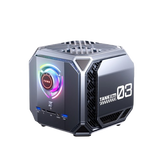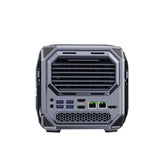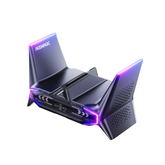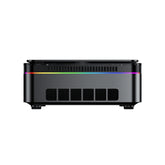Dual NIC vs Single NIC Mini PCs: Is a Dual-NIC Mini PC better?

In today's era where digitalization and networking are highly integrated, Mini PCs have gradually become the first choice for personal and enterprise users due to their compact portability and powerful performance. This article will delve into the advantages and applicable scenarios of dual NIC Mini PCs and single NIC Mini PCs, helping you make an informed decision when choosing and applying Mini PCs.
By conducting an in-depth analysis of dual NIC and single NIC Mini PCs, we will help you understand the benefits of different network configurations. Whether you need a stable and high-speed network connection or require network security isolation, this article will provide valuable references for you. We hope that through this introduction, you can more accurately select the Mini PC that suits your needs.
Dual NIC Mini PCs
A dual NIC Mini PC refers to a miniature personal computer equipped with two network interfaces(LAN Ports). These two network interfaces are usually Ethernet ports, allowing the device to connect to two independent networks simultaneously or configure the network in a more complex manner. Common specifications and hardware configurations include high-performance processors, large-capacity memory, and high-speed storage devices, as well as Gigabit Ethernet ports or even faster network interfaces. These configurations ensure that dual NIC Mini PCs can meet application scenarios requiring higher network performance and data processing capabilities.
By utilizing a Mini PC with dual NIC, users can achieve greater network flexibility and performance compared to single NIC models. This makes the dual NIC Mini PC an ideal choice for more demanding networking tasks.
Advantages
Network Redundancy and High Availability: With two network interfaces, a dual NIC Mini PC can implement network redundancy. When one network interface fails, the other can continue to operate, ensuring continuous system operation and enhancing network reliability and availability.
Enhanced Network Bandwidth: Dual NICs support link aggregation, which can combine the bandwidth of two network interfaces to improve overall network throughput. This meets the needs of high-bandwidth applications, such as high-definition video transmission and big data exchange. A Mini PC dual NIC setup is particularly beneficial in scenarios where network performance is critical.
Network Isolation and Enhanced Security: By utilizing dual NICs, different network traffic can be assigned to separate network interfaces, achieving physical-level network isolation. This isolation enhances system security, effectively preventing unauthorized access and data leakage, suitable for scenarios with high security requirements. A dual NIC Mini PC provides this capability inherently.
Supports Complex Network Configurations: Dual NIC Mini PCs support advanced network functions such as VLANs (Virtual Local Area Networks) and load balancing. Through VLANs, the network can be divided into multiple virtual networks for fine-grained network management; load balancing can optimize the use of network resources, improving system performance and response speed.
Applicable Scenarios
Enterprise-Level Applications: In enterprise networks, dual NIC Mini PCs can be used to build high-performance network devices, such as firewalls, routers, and gateways, providing stable network connections and secure network environments.
High-Performance Servers: For servers requiring high-speed network connections, such as database servers and file servers, dual NICs can provide higher bandwidth and more stable network connections, enhancing server performance and reliability. A Mini PC with dual NIC is ideal for these demanding server applications.
Virtualization and Multi-Tenant Environments: In virtualization environments, dual NICs can be used separately for management networks and business networks, or provide independent network interfaces for different virtual machines, achieving effective network resource isolation and allocation to meet multi-tenant needs.
Professional Network Management and Monitoring: Network administrators can use dual NIC Mini PCs for network monitoring and management. One NIC is used to receive the network traffic to be monitored, and the other NIC is used to manage and access the monitoring system, ensuring that the monitoring process does not affect normal network operations, thereby improving management efficiency.
Comparison Between Dual NIC and Single NIC Mini PCs

Dual NIC Mini PC vs Single NIC Mini PC: Performance
Data Transfer Rate: Dual NIC Mini PCs, equipped with two network interfaces, can increase data transfer rates through link aggregation by combining the bandwidth of two NICs, improving overall network throughput. This means that a Mini PC dual NIC setup can better meet the needs of high-bandwidth applications. In contrast, single NIC Mini PCs have only one network interface, limited by the bandwidth of a single NIC, resulting in relatively lower data transfer rates and an inability to meet the demands of high-bandwidth application scenarios.
Network Load Handling Capability: Dual NIC devices demonstrate stronger capabilities in handling network loads. They can distribute network traffic across two NICs, reducing the load pressure on a single NIC and improving network response speed and stability. Single NIC devices may experience performance degradation when facing high traffic or complex network environments due to excessive load, unable to effectively cope with network congestion and latency issues.
Dual NIC Mini PC vs Single NIC Mini PC: Cost
Initial Purchase Cost: Dual NIC Mini PCs usually have a higher initial purchase cost due to the addition of extra network interfaces and related hardware configurations. For users with limited budgets and simpler network needs, single NIC Mini PCs are more economical and suitable for basic network application scenarios.
Operating and Maintenance Costs: Running dual NIC devices may result in slightly higher energy consumption and maintenance demands, such as managing the configuration of dual NICs and ensuring both NICs function properly. These factors may increase long-term operational costs. Single NIC devices, due to their simple structure, have relatively lower operating and maintenance costs, making daily management more convenient.
Dual NIC Mini PC vs Single NIC Mini PC: Energy Efficiency
Power Consumption Comparison: Dual NIC Mini PCs, owing to the added NIC component, may have slightly higher overall power consumption compared to single NIC devices. However, modern NICs generally have low energy consumption, and this difference accounts for a small proportion of total power consumption, which can be negligible for most users.
Cooling Requirements: The additional NIC may generate extra heat, requiring better cooling designs to maintain stable device operation. Dual NIC devices may need more advanced cooling systems to ensure temperatures remain within safe ranges under high loads. In contrast, single NIC devices generate less heat and have relatively lower cooling requirements.
Dual NIC Mini PC vs Single NIC Mini PC: Security
Network Isolation Capability: Dual NIC Mini PCs can achieve true physical network isolation by assigning different network traffic to separate NICs, enhancing network security and preventing interference and potential security threats between different networks. Single NIC devices can only achieve network isolation through software or logical means, providing relatively weaker security.
Redundancy for Security Assurance: Dual NICs provide network redundancy capabilities. When one NIC or network connection fails, the other NIC can immediately take over, ensuring continuous network connection and reliability. This redundancy mechanism offers additional security assurance for mission-critical applications. Single NIC devices lack this redundancy capability, and network failures may lead to service interruptions.
Dual NIC Mini PC vs Single NIC Mini PC: Flexibility and Scalability
Flexibility of Network Configuration: Dual NIC Mini PCs support more complex network configurations, such as setting up different subnets, configuring VLANs, and implementing load balancing, meeting diverse network needs. Users can flexibly adjust network structures according to requirements, improving network management efficiency. Single NIC devices are limited in network configuration and cannot achieve these advanced functions.
Feasibility of Future Expansion: Dual NIC devices provide more room for future network expansion. Users can add new network services or connections on the existing basis to adapt to business development needs. Single NIC devices have bottlenecks in scalability; if additional network functions are needed in the future, it may require replacing devices or adding external network interfaces, increasing costs and complexity.
Selection Guide

Choosing Based on Needs
When selecting between single NIC and dual NIC Mini PCs, it's essential to assess your usage requirements. For home users, primarily used for daily internet browsing, media entertainment, and simple network applications, a single NIC Mini PC is typically sufficient. It features low cost, low power consumption, and easy operation, meeting the general networking needs of households.
However, enterprise users face more complex network environments involving large data transmissions, security, and network reliability requirements. In this case, a Mini PC with dual NIC is more suitable. It offers network redundancy, load balancing, and network isolation, supporting complex network architectures to meet enterprise-level application needs.
Additionally, consider the workload of application tasks. For lightweight applications, such as office software, web browsing, and video playback, single NIC devices can run stably. For heavy-load tasks, such as server deployment, virtualization, and multi-user concurrent operations, dual NIC devices provide better performance due to higher network bandwidth and stability.
Budget Considerations
Budget is also a critical factor in device selection. Conduct a cost-benefit analysis to balance initial investment and actual needs. Single NIC Mini PCs have a lower initial purchase cost, suitable for users with limited budgets and simpler requirements. For scenarios that do not require advanced network functions, this is a cost-effective choice.
However, from a long-term investment return perspective, dual NIC Mini PCs, despite a higher initial cost, may offer greater value in an enterprise environment. The enhanced network reliability and security they provide can safeguard business operations, reducing losses caused by network failures and offering higher investment value in the long run.
Technical Support and Maintenance
When choosing a device, consider your capacity for technical support and maintenance. Dual NIC Mini PCs offer more powerful functions but also mean higher technical complexity. Their advanced network configurations (such as VLANs and load balancing) require professional knowledge for management and maintenance. This may increase maintenance resource demands, necessitating personnel with network management experience.
In contrast, single NIC Mini PCs are simpler in structure and easy to configure. The technical requirements for daily maintenance are lower, suitable for users or small organizations lacking professional IT support. Therefore, before making a choice, evaluate your technical capabilities and available maintenance resources to ensure the selected device can be effectively managed and operated stably in the long term.
Conclusion
In summary, dual NIC Mini PCs and single NIC Mini PCs each have their advantages and disadvantages. Dual NIC Mini PCs excel in performance, offering higher data transfer rates and network load handling capabilities. They can implement network redundancy, enhance security, and support complex network configurations, making them suitable for enterprise-level applications and heavy-load tasks. However, they come with higher initial purchase and maintenance costs and greater technical complexity. In contrast, single NIC Mini PCs have the advantages of low cost, low power consumption, and easy operation. They are suitable for home users and lightweight applications but may not meet the demands of high-end applications in terms of network performance and security.
When choosing a Mini PC, the most important thing is to make an informed decision based on your specific needs. If you're a home user mainly engaged in daily office work, entertainment, and simple network tasks, a single NIC Mini PC will suffice and offers high cost performance. For enterprise users or those needing to handle high-performance, multi-task network application scenarios, a dual NIC Mini PC will provide stronger functions and security guarantees. By comprehensively considering budget, application needs, and technical capabilities, you can choose the most suitable device to ensure system stability and long-term development.
FAQs
Why does Acemagic S1 have two LAN ports?
The Acemagic S1 features two LAN ports to enhance networking capabilities by providing increased flexibility and performance. Having dual LAN ports allows the device to connect to two separate networks simultaneously, enabling network redundancy—if one connection fails, the other can maintain network access. This setup also supports link aggregation, which combines the bandwidth of both ports for faster data transfer rates. This is particularly beneficial for users who require stable, high-speed network connections, improved security through network isolation, or advanced networking configurations like VLANs.
What are the benefits of two network cards?
Two network cards offer several benefits that enhance a PC's networking performance and reliability. They enable network redundancy, ensuring continuous connectivity by allowing one card to take over if the other fails. Dual network cards support load balancing, which improves data transfer speeds by distributing traffic across both cards. They also provide the ability to connect to separate networks for network isolation, enhancing security. Furthermore, two network cards allow for advanced network configurations like VLANs and link aggregation, offering greater flexibility and scalability for future networking needs.
Related Article
Mini PC vs Stick PC Comparison: How to Choose the Best Portable Device
Mini PC vs SFF PC: Compact Desktop Computer Comparison
Mini PC vs All-in-One (AiO) PC: Which One Is Right for You?
Enhancing ACEMAGIC AMR5 Mini PC Performance with an External GPU
Mini PC vs. Traditional Desktop: Which Is Right for You
Raspberry Pi 5 vs Mini PC: Your Guide to Choosing the Right Device







Leave a comment
Please note, comments need to be approved before they are published.